The bougainvillea tree is an ideal pick if you are looking for a tough tree with beautiful blooms that can withstand heat and drought.
This article will guide you on bougainvillea varieties, growing, and caring instructions.
What is bougainvillea?
Bougainvillea is a widespread genus of roughly 18 species of shrubs, vines, and small trees native to South America. It belongs to the Nyctaginaceae family. Many plants of this species have thorns, yet only woody vines have gained widespread popularity. Some species have generated highly ornamental variants frequently grown indoors and adored by everyone.
The tiny flowers of bougainvillea are surrounded by brilliantly colored papery bracts, known as paper flowers in one species, B. glabra, from Brazil. The bracts primarily range from purple or magenta to lighter shades in some variants.
In warm areas, it can grow to be 20 to 30 meters (60 to 100 feet) in height, and the plant blooms throughout most of the year. The flowers fascinate everyone around them, and the stalk is covered in numerous tiny hairs.
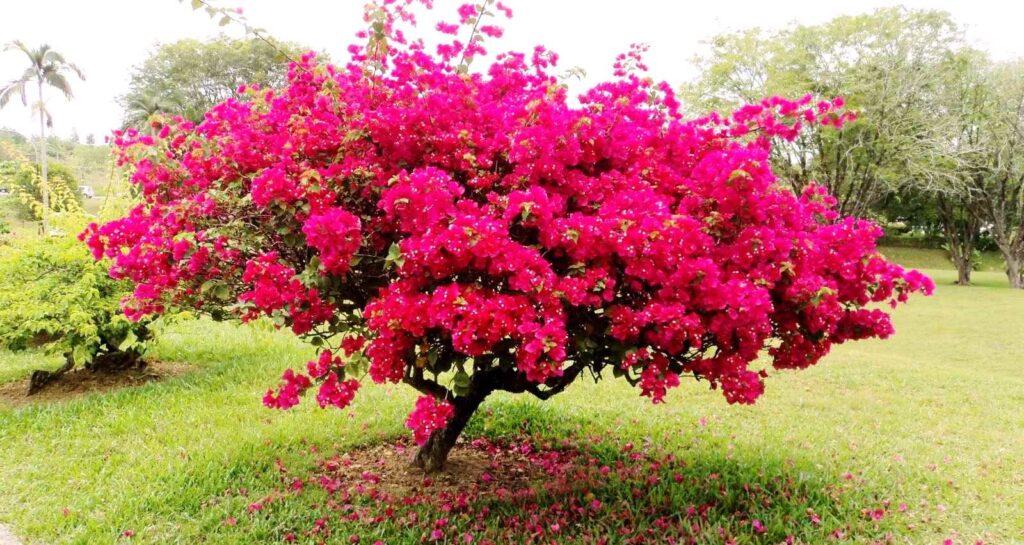
Bougainvillea varieties
There are over 250 varieties of bougainvillea. In this article, we will mention some of the most popular varieties.
Check out these popular Bougainvillea Bonsai Plants
1) Dwarf Bougainvillea
Dwarf bougainvilleas can attain a height of 3 to 5 feet and a spread of 3 to 5 feet. These bougainvillea varieties are ideal for tight areas or containers. They’re relatively easy to care for and might be sold as little bougainvilleas. Some people prefer prune to resemble a shrub rather than an ambling vine. If you are on a hunt to cover a miniature landscape or plant it in a container, these charming dwarf bougainvilleas are a perfect pick.
a) Sunvillea Rose
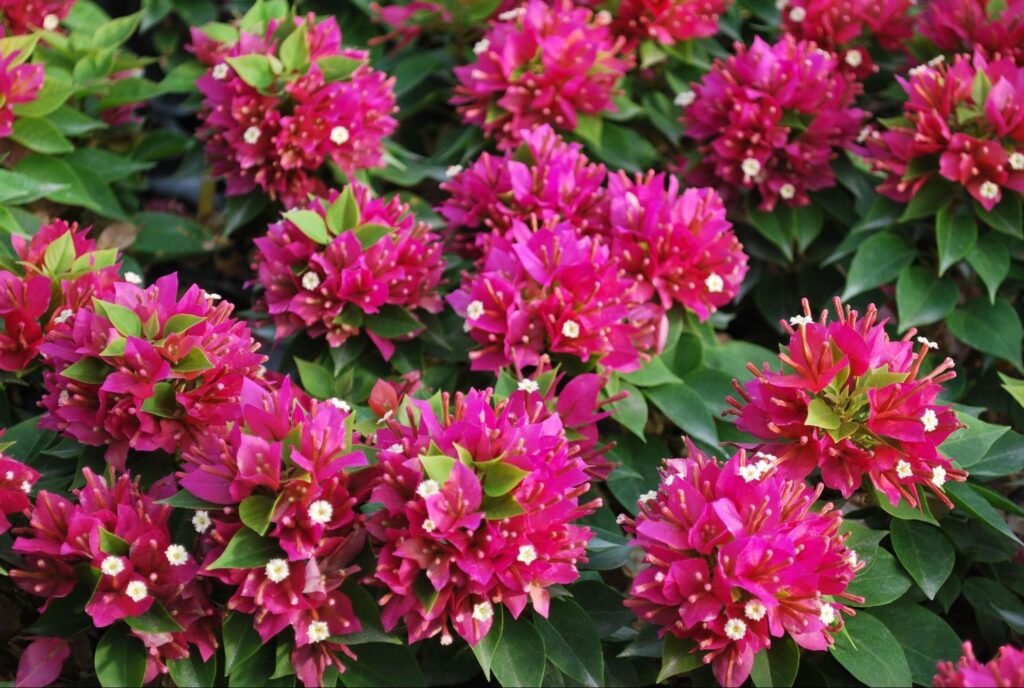
These miniature bougainvillea varieties have bright pink or magenta bracts, and it blooms all summer. In frost-free locations, these are known to have green foliage and are evergreen. It can attain a height of 2 to 3 feet with a great spread of 12 to 2 feet. It prefers full sun and just needs additional watering on occasion.
b) Helen Johnson
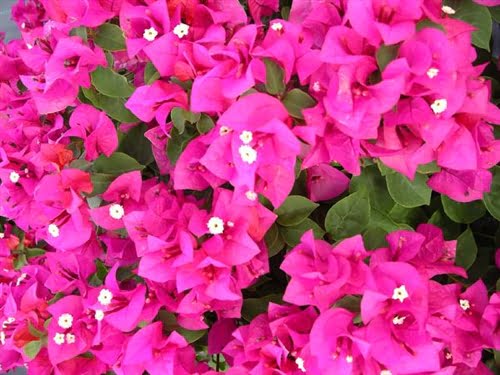
It is a dwarf species that works well as a ground cover in rock gardens or as a border along a garden path. These bougainvillea varieties grow to 3 feet tall and produce a profusion of coppery bracts. They have vivid pink blooms with purple undertones. Their small, greenish-tan leaves mature to deep, dark green on this hardy perennial plant, making a remarkable color contrast. Flower buds have a coppery-orange color when they first open, but they turn bright pink as they mature. In nutrient-rich soil, these thrive well in containers or hanging baskets. It grows best in acidic, well-drained soil and enjoys full sun or soft shade.
c) Sunvillea Cream
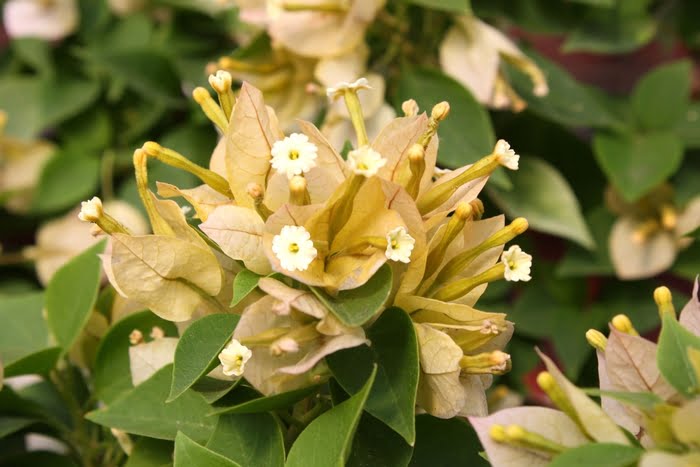
These bougainvillea varieties could be the answer to lighten up your home. It brightens a partially shady region of your environment. Sunvillea Cream blooms from early spring to late summer with creamy white bracts and a 2-foot spread and develops to heights of 1 to 3 feet with a 2-foot spread. It looks great in pots with blues and bright pinks or as a stand-alone instance.
d) Pink Pixie
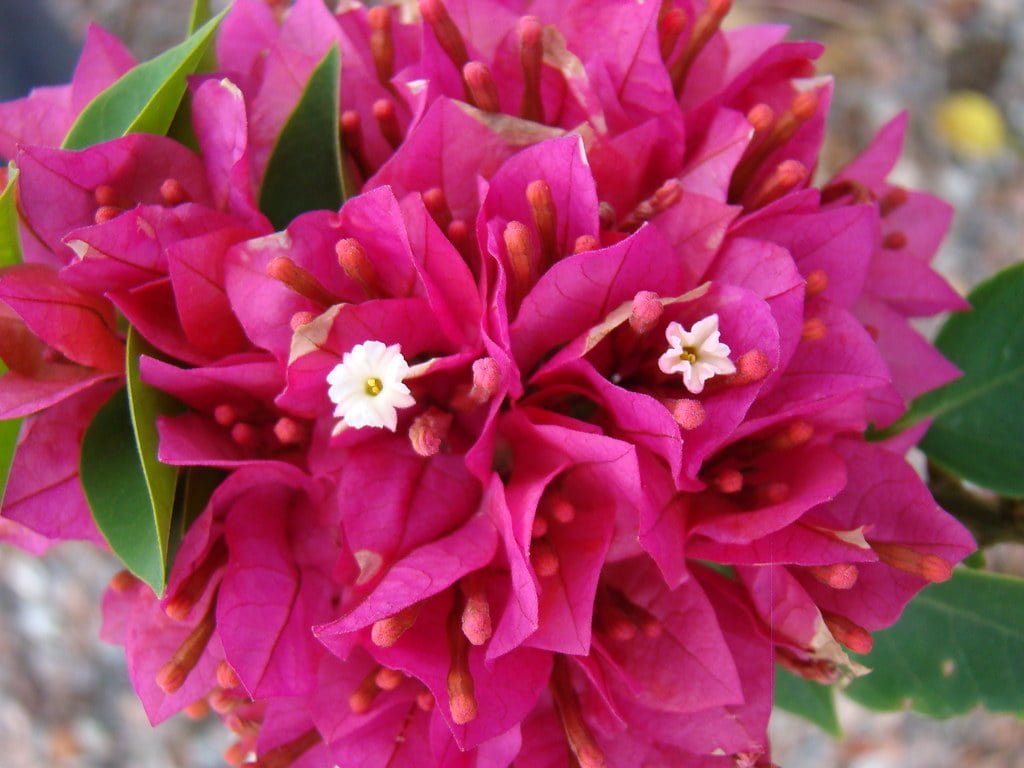
Pink pixies attract birds and butterflies. These produce an abundance of densely packed pink blossoms on yellow-green leaves. These varieties grow 2 to 4 feet tall with a 2 to 3-foot spread. It prefers full light and soil that is relatively dry and well-drained.
2) Semi-Dwarf
These bougainvillea varieties are some of the best picks if you want to brighten up your spot. They’re usually better suited to growing in the ground because they’re too big for containers. If you want to fill a limited space in your garden, Semi-dwarf bougainvilleas are best.
a) Imperial Delight
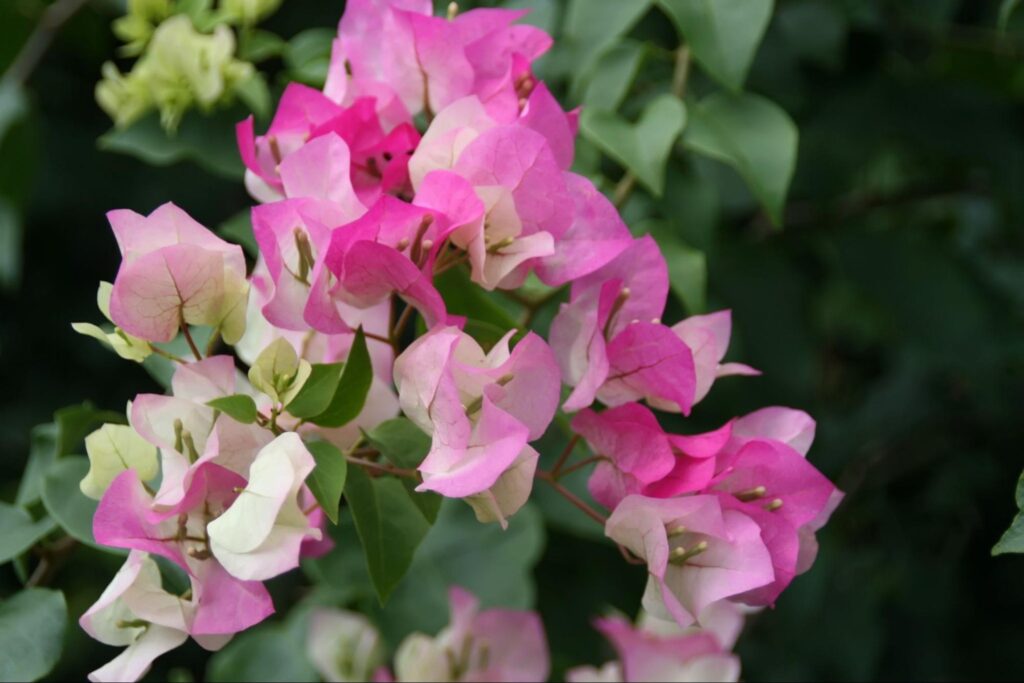
The bracts of this spectacular bougainvillea turn a delicate pink as they age, giving the appearance of bi-colored flowers. They put on the most spectacular display of color in the spring and early summer, although they bloom all year. Imperial Delight can grow to a height of 10 to 20 feet, but with light pruning, one can keep it to a size of 6 to 8 feet. It prefers acidic, well-drained soil and full sunlight.
b) Miss Alice
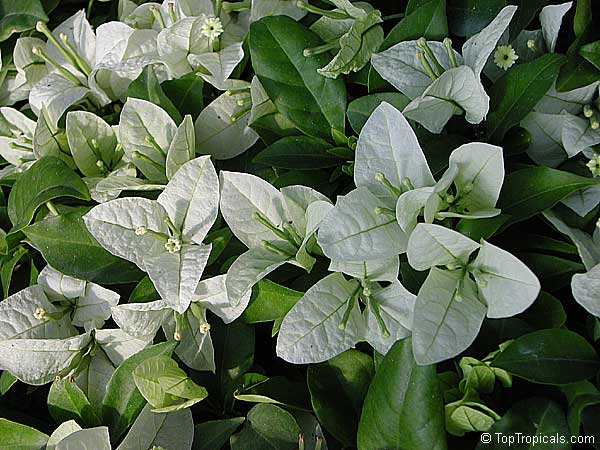
Miss Alice is a semi-dwarf, compact shrub with big blooming bracts. The light green foliage contrasts perfectly with the stunning white blossoms. Although it may grow a few thorns, it is also called thornless. It blooms throughout the summer and can withstand rain and high humidity. It grows to be 3 to 6 feet tall with an equal spread. It prefers full light for 5 hours per day.
3) Bougainvillea, giant or full-sized
Whether giant or full-sized, Bougainvillea varieties add color and beauty to the environment. These gigantic vines require a lot of space to thrive.
a) Lady Baring
These are also known as ‘Yellow Glory,’ or ‘Hawaiian Gold,’ a strong, fast-growing evergreen vine that thrives in full sun for at least five hours daily. It gives vivid color to home landscapes with its huge clusters of bright yellow flowers. Its broad and robust branches make it ideal for climbing a garden wall. These bougainvillea varieties have round, leathery leaves in vivid green color. This variety reaches a height of 25 to 30 feet and a width of 8 to 10 feet, demanding a lot of areas.
b) Barbara Karst
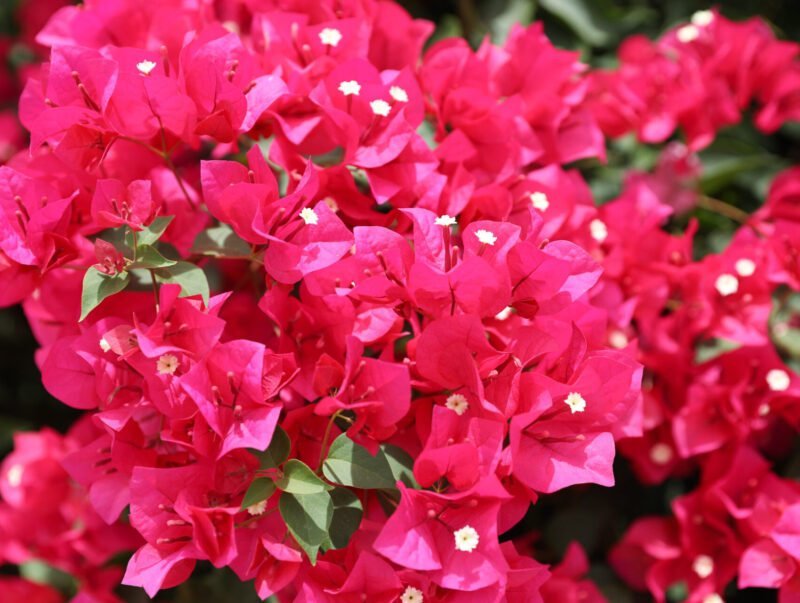
This robust, water-wise bloom makes a superb covering for patios and arbors in frost-free climates, and it stays evergreen—these showers masses of pink blossoms. It thrives in full sun and prefers slightly acidic, well-drained soil. In locations where there is no frost, it blooms all year.
c) Orange King
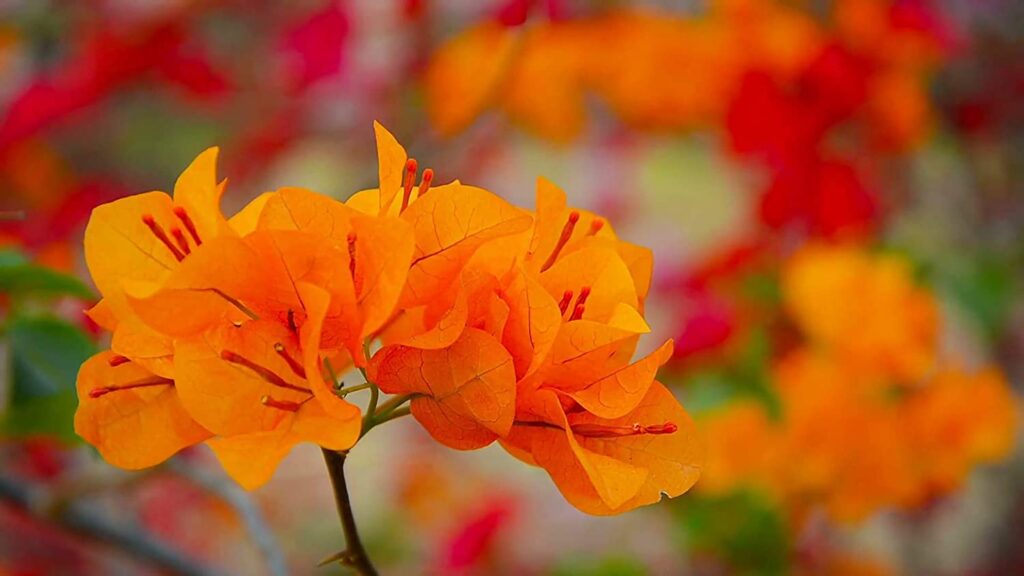
Bougainvillea ‘Sunset Orange’ bracts begin bright orange, fade to coral, and mature to salmon pink. The flowers catch the eye of everyone around them. It blooms in the summer and reaches a height of 20 feet. It thrives in soil that is somewhat dry and well-drained.
d) James Walker
The bougainvillea varieties bloom nearly all year and produce reddish-purple blooms with a delicate white core. James Walker grows to a height of 20 to 30 feet. It grows well in full sunlight and moderately moist, well-drained soil.
4) Thornless
Miss Alice, a thornless cultivar, is renowned for its dazzling white flower clusters and semi-dwarf growth habit. Singapore White, Mauna Kea White, and Moonlight are just a few of the titles given to Bougainvillea tree Miss Alice. It has medium to dark green leaves that are long and elliptical. The plant grows to a mature height of 2 to 3 feet tall. The Bougainvillea is used for covering ground or mass planting. Singapore Pink, a semi-thornless sister variety of Miss Alice, has pale pink blooms.
After listing Bougainvillea varieties, now we will cover how to propagate the Bougainvillea tree.
How to Propagate Bougainvillea tree
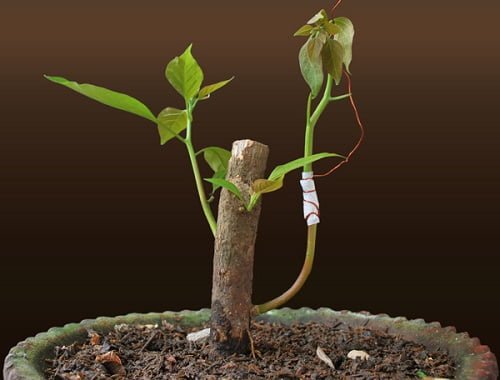
One of the most reliable ways to propagate the Bougainvillea tree is through stem cuttings.
You can start by cutting the stem of an existing plant 6–8 inches from the base, coat it in rooting hormone, and place it in a shallow container filled with well-drained potting soil. Now, you should cover that cutting with a plastic bag and put it somewhere dark and in a more relaxed place after thoroughly watering. Cuttings will develop into the plant with minimal interference in as little as 3-6 months.
Now, we discuss this in detail for your better understanding.
1) Take a Cutting
a) Cut a mature stem to 6–8 inches
We advise you to take cuttings from healthy plants that show no symptoms of disease or infestation. You should begin by snipping the bottom end of the stem at a 45-degree angle with a pair of sharp pruning shears. Cutting the stem at an angle will elevate the surface area, allowing it to absorb more moisture and nutrients from the planting soil.
Note:
- Choose a cutting with at least seven nodes to generate a healthy plant.
- We highly recommend using gardening gloves and eye protection for the propagation process.
- Rather than younger parts that are still green, use semi-ripe or hardwood for your cuttings.
- The most significant time to take bougainvillea tree cuttings is from late spring to mid-summer when growth is at its peak.
- It might be challenging to get the bougainvillea tree to root. If your initial attempt fails, do not panic; take other cuttings to offer yourself a second chance.
- Before and after you take a cutting for propagation, sanitize your gardening tools with rubbing alcohol to disinfect them.
b) Remove the leaves from the stem and prune them.
The bougainvillea’s stem is the only portion of the plant that will take root. It would be best if you would remove all blooms, leaves, and minor offshoots from the narrow, woody shaft. Any still green portions should be trimmed and discarded, as they are less likely to survive when planted.
Note:
- Make sure you remove half of the leaves from the stem of the bougainvillea.
- It will ensure that the plant’s resources are fully utilized to form new roots.
- Now, wrap your bougainvillea cuttings in a wet paper towel and put them in an airtight plastic bag. (You can place it in the fridge if you are not planning on rooting them straight away.)
c) Apply rooting hormone
Place the cuttings in a powdered rooting hormone container. Tap the stem lightly with your fingertip to remove any extra powder. Avoid caking or clumping by completely coating the underside.
Note:
You can also make your rooting hormone home with apple cider vinegar, cinnamon, honey, or crushed aspirin.
2) Planting the Cutting
a) Fill a small container with well-drained soil.
Pick a growing medium for propagation from seeds and cuttings for the most excellent results. A blend of commercial potting soil, organic garden compost, and sand are suitable for propagation. You should give a room at the top of the container for watering.
b) Insert the cutting into the soil
To ensure that the stem is firmly secured:
- Sink it 2-3 inches below the soil’s surface.
- If you’re working with a denser soil mixture and are concerned about damaging the stem, make a narrow hole with a pencil or other sharp tool beforehand.
- Give your cuttings a home environment to relax and thrive well.
Note:
- Your stem can develop more roots if inserted at a modest slant into the soil.
- To provide plenty of room for development and avoid gathering, you should use one cutting per pot.
c) Water your cutting thoroughly
You should water the cuttings enough to wet the soil’s surface. Allow the cutting to sit undisturbed after watering.
Note:
- Make sure not to overwater your newly planted cutting. Too much moisture can restrict the rooting process or cause more severe problems like rotting or fungal infection.
d) Placing a plastic bag over the cutting
The surrounding layer of plastic will create a little greenhouse effect, trapping humidity. The amount of moisture will enable the cutting to begin developing on its own in just a few weeks. You should select a cool, shaded area inside your home away from direct heat or sunlight to store the cutting once it’s been covered.
Note:
- Close the bag by tying or zipping it or wrapping the plastic cover over the top of the pot and ensure that the bottom is weighted and secured.
e) Within 6-10 weeks, the cutting should start growing.
When tiny green leaves appear along the stem of your bougainvillea tree cutting, you’ll know it’s taken root. During the process, don’t remove the bag or damage the plant. This may obstruct the rooting process. In most circumstances, it’s advisable to wait until many offshoots emerge along the stem before uprooting it.
3) Preparing Developing Plants for a Container
a) Allow the cutting to root for another 4-6 weeks or until 4-6 leaves develop.
Depending on the status of the cutting and your specific soil conditions, this process could take anywhere from 3-6 months. You should repot the stem in a larger container or transfer it to your garden after the stem begins to produce leaves again. Because the roots haven’t fully formed, there’s no need to water the cutting more often.
b) Gradually expose the rooted cutting to full sunlight.
You should relocate the plant to a location with slightly more direct sunlight every 5-7 days. A gradual acclimation procedure will aid it in adapting to its new surroundings and increasing its chances of survival.
Note:
- Your bougainvillea tree can die if you put it in bright sunlight before it’s ready to bloom, leaving you in vain after all these efforts.
- You should flourish them with enough sunlight so that they can thrive well.
c) Maintain the right temperature between 18 and 24 degrees Celsius
You should limit the plant’s exposure to extremes of heat and cold throughout this time. We advise you to bring it inside during the hottest part of the afternoon and after the sunsets.
Note:
- Bougainvillea tree prefers to be at the same temperature as you. As a result, the optimum spot for it will almost always be within your home.
d) Remove the clipping and replant it in its new location.
You should remove the entire pot carefully and place it in a container or flower bed, where it will continue developing independently.
Note:
- Plant your bougainvillea tree in the spring or summer, so it has time to establish itself before the cold weather sets in.
- You should give your cuttings enough room to expand out. Its container or plot should be twice as large as its growing root system.
- The roots of the bougainvillea tree don’t like being disturbed after they’ve established themselves.
Now, when we have learned about bougainvillea propagation, let’s cover how to grow bougainvillea trees.
How to Grow Bougainvillea tree
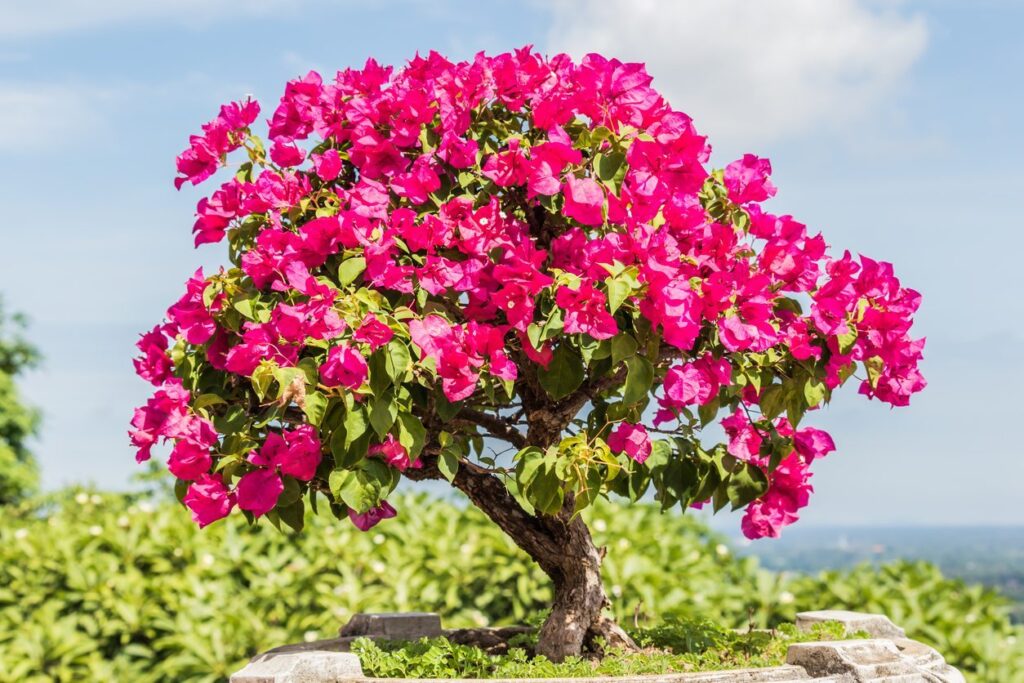
Growing requirements
- Plant bougainvillea thrives in full sun, slightly acidic, well-drained soil.
- Do not overwater your tree.
- Fertilize every few months, prune at the end of the season, and train your bougainvillea plant to climb an adjacent wall or trellis.
1) Choose whether you want to plant in the ground or in a container.
The Bougainvillea tree thrives in hot, dry environments. If you live in a colder region, bougainvillea can be grown in a pot and brought within for the winter.
Bougainvillea tree thrives at temperatures that do not go below 16℃ at night and do not surpass 38℃ during the day.
You can also place your Bougainvillea tree in the basement or another dark room throughout the winter.
2) Locate a sunny area in your yard.
Bougainvillea tree adores sunlight and thrives in full light. Bougainvillea tree requires at least six hours of direct sunlight per day to grow. Place your bougainvillea tree in a sunny spot.
3) Select a location with fertile, well-drained soil.
Bougainvillea trees will not thrive in soil that absorbs water, so make sure it drains well. You should amend the soil with sand, peat moss, perlite, or vermiculite. Planting on a slope can also help with drainage. They require rich, slightly acidic soil with a pH of 5.5 to 6.0.
- If necessary, add limestone to the soil to raise the pH or sulfur to lower the pH.
- If you put the bougainvillea tree in a pot, be sure the soil mix has the right pH level.
4) Plant the bougainvillea tree
Dig a hole as deep as the root ball of the bougainvillea plant. Fill the hole with a high-phosphate fertilizer to encourage root growth and flower blooming. Remove the bougainvillea tree from its container, knock the roots, and place the root ball in the wet hole. Pat the soil lightly around the plant’s base.
- Plant the bougainvillea tree near the structure if you want it to climb a trellis or wall. You’ll need to “teach” it to climb the structure as it grows by gently wrapping it around the foundation.
- If you’re going to plant the bougainvillea in a container, make sure it has a lot of drainage holes because bougainvilleas don’t like having wet feet.
How to plant Bougainvillea tree
- Bougainvillea trees need a lot of sunlight. Getting those bright pink blossoms requires at least six hours of direct sunlight per day. Pick a location that receives full sunlight to help the tree thrive well.
- The soil needs to be well-drained. They prefer loose, grittier soil. They dislike being wet for lengthy periods and can succumb to the root rotting in thick soil.
- You should pay more attention to the roots as they are thin and can be damaged during transplantation.
- After planting, water the bougainvillea plant once a week until it is established.
We have covered everything you need to know about planting the Bougainvillea tree. Now, we dive into the care instructions for the Bougainvillea tree.
How do you care for the Bougainvillea tree?
- Prune your tree every year, especially before the new growth cycle begins in late winter. You should trim all branches to 20 feet or less for the finest flowering. Bougainvillea blooms on new growth; thus, you can prune each bloom cycle.
- You should pinch off every vine end that is about to bloom. The bracts will be more densely displayed.
- You won’t need to water the vine once it’s established if you have steady rain. The Bougainvillea tree prefers a dry climate. It is like a deep, three- to four-week irrigation compared to frequent shallow waterings. If you overwater a bougainvillea tree, it might get fungal infections and root rot.
- Bougainvillea blooms better if it is kept dry. There will be a lot of green growth and fewer blossoms if you use too much water. If you are a fan of flowers, try to keep the Bougainvillea tree as dry as possible.
- The cold is an issue. These tropicals don’t like it when the temperature drops below 30 degrees. They can tolerate a light freeze for one or two nights, but anything longer than that would kill them. Established trees can withstand a cold spell better than newly planted ones.
- You can fertilize it sparingly. This hardy Bougainvillea tree doesn’t demand it. However, add compost to the soil around it. In the spring, a 3-inch coating of compost is sufficient.
This section will cover the growing and caring requirements of a bougainvillea in pots.
How to Grow and Care Bougainvillea in Pots
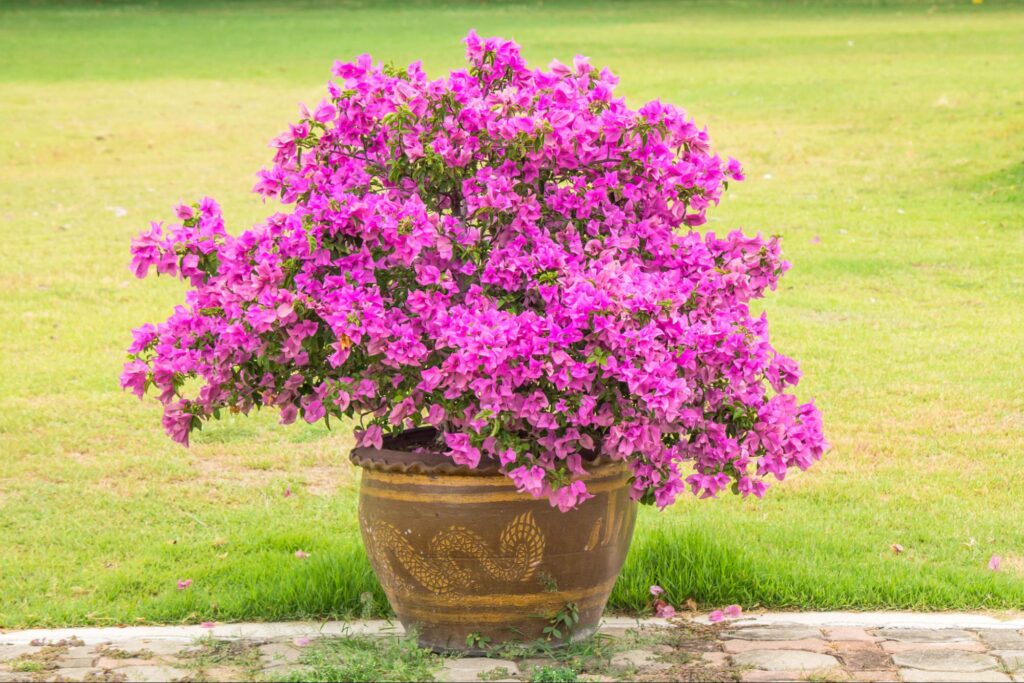
Growing Requirements for Bougainvillea in pots
If you don’t live in a climate where it never freezes but still wants to grow bougainvillea, there’s good news: it grows well in pots. Because bougainvillea flowers more when its roots are packed, planting it in a pot transforms it into a flowering machine. Bring your potted bougainvillea indoors and place it near a sunny window when the winter chill sets in. Here’s everything you need to know about potted bougainvillea.
- Select a pot with drainage holes. Otherwise, your bougainvillea tree will succumb to root rot and die.
- You should use potting soil that drains properly and doesn’t contain a lot of peat moss. Peat moss holds moisture and may cause root rot in bougainvillea in pots.
- Water the bougainvillea frequently enough to keep the soil moist until it is established. Ensure you water your Bougainvillea when the top inch of the soil is dry. If the soil is a little dry, Bougainvillea tends to bloom more.
- Bougainvillea prefers thorough waterings infrequently over shallow waterings regularly. Fill the pot with water until it runs out the holes in the bottom.
Soil
Bougainvillea in pots prefers a porous, well-draining substrate. The best choice is a loamy soil mixture that has been treated with organic compost. We suggest you use a combination of 3 parts ordinary potting soil and 1 part succulent and cactus mix. Remember that peat moss enhances water retentiveness; therefore, don’t use much of it in your soil.
Sunlight
Bougainvillea in pots requires at least 6 hours of full sun per day. It assures a plentiful supply of flowers while maintaining the plant’s appearance. Bougainvillea tree also enjoys the heat and blooms throughout the year’s hottest months.
Flowering will be poor, and the plant will appear weak and leggy if it does not receive enough sunlight. So, while bougainvilleas tolerate part sun, they will not look as attractive as those grown in full light. If your plant isn’t blooming, lack of sunlight might be the reason.
Water
Age is a consideration when you are concerned about watering Bougainvillea in pots. Make sure to water your bougainvillea regularly during the first few years of its life. Just keep a lookout for one that has just been planted.
Once established, Bougainvillea is more drought-tolerant. It would rather have good, deep waterings than many shallow ones.
When watering and cultivating bougainvillea in pots, remember that pots have a drainage hole. It is one component that contributes to good drainage.
Don’t overwater Bougainvillea because it’s susceptible to various root rots. It is also where the soil plays a role; it needs to be well-drained and aerated to help avoid rot.
Note:
- You should water the established bougainvillea in pots after the top 2-3 inches of soil have dried.
- You should water the pot more frequently if it’s smaller.
- If the temperature rises, you’ll need to water more regularly and less in the winter.
- If your plant is new, water it more frequently.
- As the bougainvillea matures, you don’t have to worry about the watering schedule.
Temperature
Bougainvillea is a resilient tropical plant that thrives in temperatures ranging from 5 to 28℃.
Pruning
It is crucial to keep the bougainvillea plant’s size in check and encourage new development. One should prune their bougainvillea in the late fall after the flowers have faded or in the early spring, before new growth emerges, to avoid interfering with the following season’s blooming. You can prune the plant heavily in containers to keep them bushy and generate new flower-producing branches. Cut the branches to half their original length using a sterilized shear or scissor.
Steps to prune
- You can avoid spreading disease by wiping the pruning shears before rubbing alcohol or another disinfectant.
- It is the first and most crucial step when it comes to pruning. Cut back anything that appears dead or discolored to protect the bougainvillea plant’s long-term health.
- Pruning will allow the plant to open up and grow into a healthy shape. Cut away branches that appear to harm the bougainvillea plant’s health. Take a step back to admire the plant and continue pruning until you achieve the desired shape.
- Once the blooms have faded, just pinch off the tops with your fingers, then pinch back to the following nearby branch. It will foster new blooms and growth.
Note:
- The thorns on many bougainvillea varieties are thick and highly sharp and can cause injury to your hands. Some species might also cause a rash or irritate your skin. If you’re going to perform a lot of pruning, put on a pair of thick gloves beforehand. To protect your wrists and arms, you may wear long sleeves made of thick material.
- You can prune the Bougainvillea tree into many different shapes. You can even prune it to take on the shape of a little tree if you’re growing it in a pot.
- You should trim dead wood off the plant at any time of year but keep the more significant pruning cuts for early spring when the plant is less likely to be wounded.
Fertilizer
The bougainvillea tree is a heavy feeder. When the plant is established in early summer, occasionally use a slow-release fertilizer. You can give a light liquid balanced fertilizer every two weeks during the growing season. Repeat this feeding in July to maintain the plant blooming continuously for the rest of the summer and fall.
Plants in cooler climates tend dormant and lose some leaves throughout the winter. You should avoid feeding your bougainvillea tree in winter until early spring.
Support
The size of your plant will determine this. With the help of support, train the plant to grow upwards. If you have one of the larger bougainvillea varieties, you’ll need a metal trellis or a wire support system to train it to grow up or over a wall or fence.
Pests and Diseases
If kept in a bright place with good ventilation, Bougainvillea in pots rarely attracts pests. However, mealy bugs, mildew, and aphids can harm the bougainvillea plant. To treat the bougainvillea, you can use a cotton ball dipped in insecticidal or neem oil solution.
Now, we will answer some of the most asked questions by the gardeners like you.
Frequently Asked Questions
Ques1: Why is my bougainvillea not blooming?
A lack of sunlight and heat frequently causes a lack of blossoming. Bougainvillea tree adores it and requires both to bloom. Overwatering, fertilizing, and trimming a bougainvillea can prevent your tree from blooming correctly.
Ques2: Is it okay if I prune my bougainvillea tree?
Yes, you’ll need to since this plant grows quickly once the weather warms up. You should keep a check on your bougainvillea every two or three months. The sort of bougainvillea you have, your environment, and the shape you want it to take influence how often you prune it.
Ques3: How do you pick a container for the bougainvillea tree?
You can start with a 10-14 inch deep container and re-pot it in the larger one. The bougainvillea plant prefers to be little root bound, so re-pot it every two years as the roots begin to overcrowd. We suggest you choose glazed terracotta or ceramic pots to keep the roots cool during the hot months.
Conclusion
The bougainvillea tree is one of a kind when it comes to strong and flourishing with pretty flowers. The care is beginner-friendly, and this tree won’t give you much trouble. Many gardeners like bougainvillea in pots as trees require a lot of space. So, bring this plant and light up your house with its attractive flowers.
Related Articles
- The Ultimate Guide to Buying Bonsai Plants: What to Look for and Where to Buy
- Boost Your Garden’s Health: 5 Key Reasons to Start Mulching Today
- Propagating Chinese Elm Bonsai Cuttings And From Seeds
- Best Chinese Elm Bonsai Soil and Fertilizer.
- Troubleshooting Common Problems With Chinese Elm Bonsai
- Buy Chinese Elm Bonsai: How Not to Get Scammed When Purchasing a Chinese Elm Bonsai Tree!

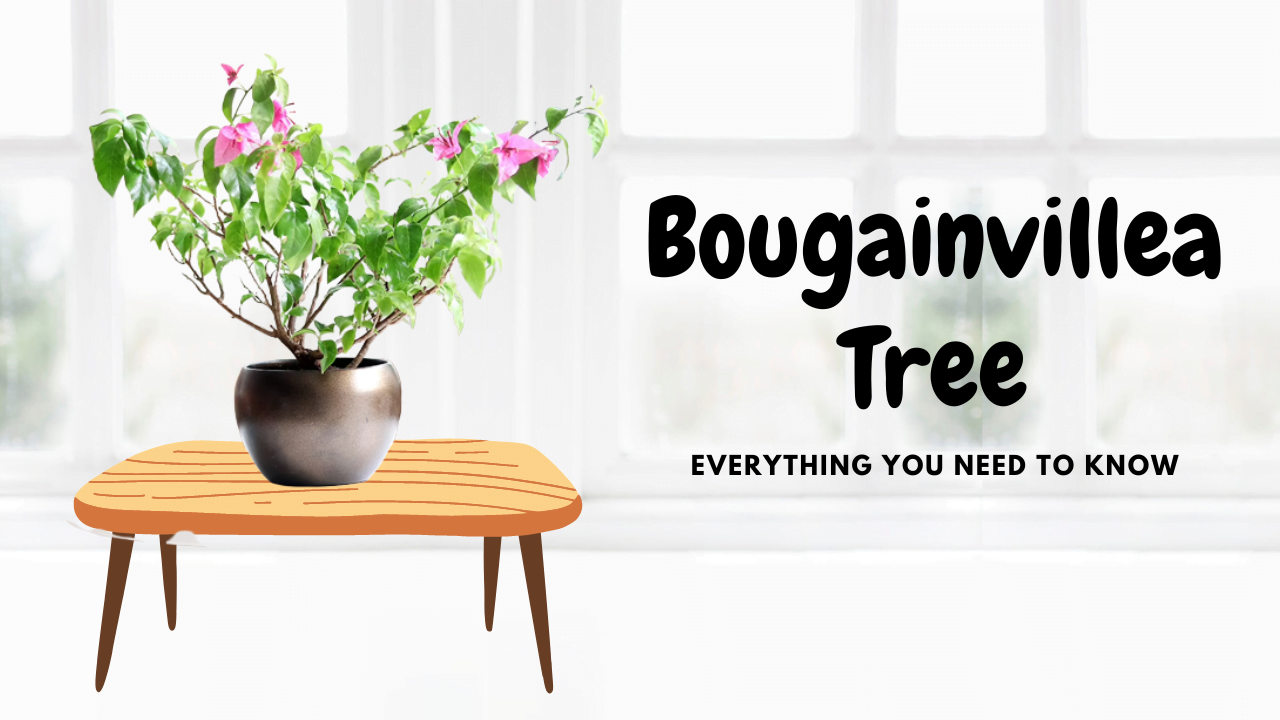

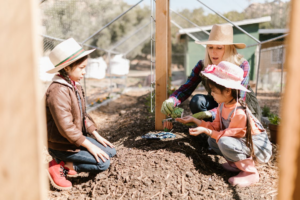

Hello
I must thank you for sharing your valuable scientific and practical business, I sincerely wish you the best of luck.
Hello
I must thank you for sharing your valuable scientific and practical business, I sincerely wish you the best of luck.